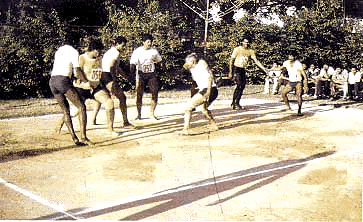| Games of Ancient India | |
| Asol Aap | |
| Boat Race | |
| Dhopkhel | |
| Gella-Chutt | |
| Hiyang Tannaba | |
| Inbuan | |
| Insuknawr | |
| Kabaddi | |
| Kang Shanaba | |
| Kho Kho | |
| Khong Kangjei | |
| Kirip | |
| Lamjei | |
| Mallakhamb | |
| Mizo Inchai | |
| Mukna | |
| Nagaland & Arunachal Games | |
| Sagol Kangjei | |
| Yubee-Lakpee Archery | |
| Kabaddi
Though kabaddi is primarily an Indian game, not much is known about the origin of this game. There is, however, concrete evidence, that the game is 4,000 year old. It is a team sport, which requires both skill and power, and combines the characteristics of wrestling and rugby. It was originally meant to develop self defence, in addition to responses to attack, and reflexes of counter attack by individuals, and by groups or teams. It is a rather simple and inexpensive game, and neither requires a massive playing area, nor any expensive equipment. This explains the popularity of the game in rural India. Kabaddi is played all over Asia with minor variations. A Kabaddi match in progress
Kabaddi is known by various names viz. Chedugudu or Hu-Tu-Tu in southern parts of India, Hadudu (Men) and Chu - Kit-Kit (women) in eastern India, and Kabaddi in northern India. The sport is also popular in Nepal, Bangladesh, Sri Lanka, Japan and Pakistan. The Game In Kabaddi, two teams compete with each other for higher scores, by touching or capturing the players of the opponent team. Each team consists of 12 players, of which seven are on court at a time, and five in reserve. The two teams fight for higher scores, alternating defence and offense. The court is as large as that for a dodge ball game. The game consists of two 20 minute halves, with a break of five minutes for change of sides. The kabaddi playing area is 12.50m x 10m, divided by a line into two halves. The side winning the toss sends a 'raider', who enters the opponents' court chanting, 'kabaddi-kabaddi'. The raider's aim is to touch any or all players on the opposing side, and return to his court in one breath. The person, whom the raider touches, will then be out. The aim of the opposing team, will be to hold the raider, and stop him from returning to his own court, until he takes another breath. If the raider cannot return to his court in the same breath while chanting 'kabaddi', he will be declared out. Each team alternates in sending a player into the opponents' court. If a player goes out of the boundary line during the course of the play, or if any part of his body touches the ground outside the boundary, he will be out, except during a struggle. Lona The team scores a lona ( a bonus of two points), if the entire opposition is declared out. The game then continues by putting all the players on both sides. Matches are staged on the basis of age-groups, and weight. Seven officials supervise a match - one referee, two umpires, two linesmen, a time keeper and a scorer. Types of Kabaddi In India, Kabaddi is recognised in three forms:
In the 'Gaminee' type of Kabaddi, there is no revival. When all the players of team are out, the game ends. So there is no time limit in this category. In the 'Amar' form of Kabaddi, whenever any player is touched (out), he does not go out of the court, but stays inside, and one point is awarded to the team that touched him. In this way, one point for each touch of the opposite team, i.e. to the team who touches the anti player. This game is also played on a time basis, i .e the time is fixed. In the northern part of the country, i.e. Punjab, Haryana, Uttar Pradesh and Delhi, this game is played in a circle. This is known as 'Circle Kabaddi' or Amar Kabaddi. If it is played without a court, as in some places, it's called 'Goongi Kabaddi'. The Goongi Kabaddi is nothing but wrestling between two players. The first world Kabaddi championship in the history of the game, was organised in Hamilton when approximately 14,000 people packed Copps Coliseum, to watch stars from India, Pakistan, Canada, England, and the United States compete. The Kabaddi Federation of India (KFI) was founded in 1950, and it compiled a standard set of rules. The Amateur Kabaddi Federation of India (AKFI) was founded in 1973. The AKFI has given new shape to the rules, and it has also the rights of modification in the rules. The Asian Kabaddi Federation was founded under the chairmanship of Mr. Sharad Pawar (Maharashtra). Some of the Arjuna Award winners are Sh. Sadanand Mahadeo Shetty, Sh. Sadanand Mahadeo Shetty, Sh. Shakuntla Panghar Kholavakar, Sh. Shantaram Jaatu, Kumari Monika Nath, Kumari Maya Kashi Nath, Rama Sarkar etc. Kabaddi was one of the demonstration games at Asiad '82. |
